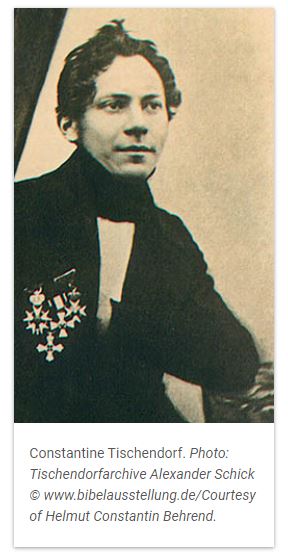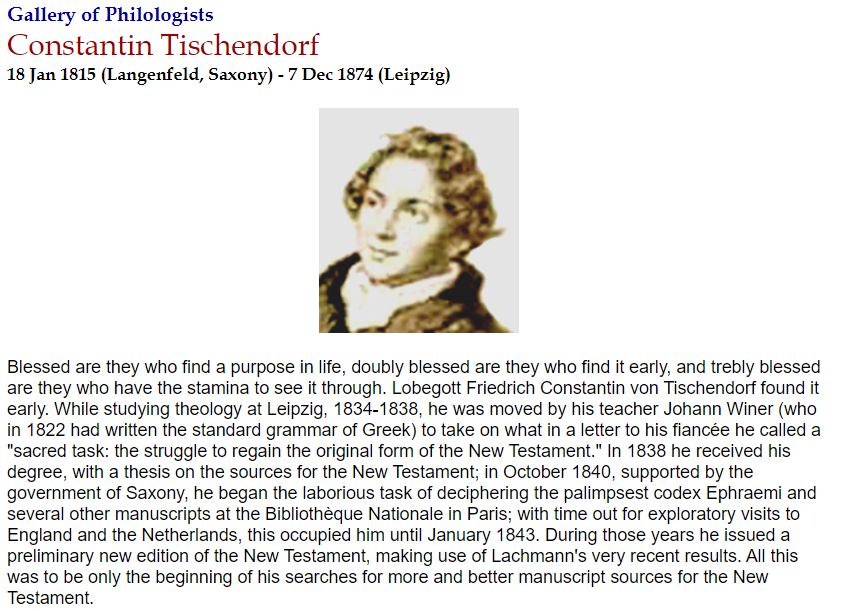Manuscripts and Versions of the Second Century

Chapter V
Manuscripts and versions of the second century
Such, then, are the weapons which we employ against an unbelieving criticism. But to complete our aim, and maintain the truth of the Gospel, we must procure a new weapon, or, rather, open a new arsenal of defence. It bears the name of New Testament Textual Criticism. It is not easy to make this at once clear to all readers: we must endeavour to do so.
The name denotes that branch of learning which is concerned with the originals of the sacred text. The inquiry into these originals should teach us what the Christian Church in various times and in different lands has found written in those books which contain the New Testament. Thus, for instance, it should teach us what was the text used by Colomba in the sixth century, by Ambrose and Augustine in the fourth, and by Cyprian and Tertullian, in their Latin copies, in the third and second century; or what the Patriarch Photius in the tenth, Cyril, Bishop of Jerusalem, in the fifth, Athanasius in the fourth, and Origcn in the third, had before them in the Greek text. The chief end of such inquiries, however, lies in its enabling us to find out the very words and expressions which the holy Apostles either wrote or dictated to their amanuenses. If the New Testament is the most sacred and precious book in the world, we should surely desire to possess the original text of each of its books, in the state in which it left its author’s hands, without either addition or blank, or change of any kind. I have already spoken of this in the account of my travel and researches, to which I here refer the reader.
If you ask me, then, whether any popular version, such as Luther’s, does or does not contain the original text, my answer is Yes and No. I say Yes, as far as concerns your soul’s salvation; all that is needful for that, you have in Luther’s version. But I also say No, for this reason, that Luther made his translation from a text which needed correction in many places. For this Greek text which Luther used was no better than the received text of the sixteenth century, based on the few manuscripts then accessible. We have already told you that this text differs in many places from the oldest authorities of the fourth, fifth and sixth centuries, and, therefore, must be replaced by text which is really drawn from the oldest sources discoverable. The difficulty of finding such a text lies in this, that there is a great diversity among these texts; we have, therefore, to compare them closely together, and decide on certain points of superiority on which to prefer one text to another.
We have in this, then, a fixed point of the greatest importance on which we can safely take our stand, that the Latin text, called the old Italic version, as found in a certain class of manuscripts, was already in use as early as the second century. The text of the old Italic is substantially that which Tertullian, about the end of the second century, and the Latin translator of Irenacus still earlier, made use of. If we had any Greek text of the second century to compare with this old Italic version, we should then be able to arrive at the original Greek text at that time in use. We should thus be able to approach very nearly to the original text which came from the Apostles’ hands, since it is certain that the text of the second century must resemble more closely that of the first than any later text can be expected to do. Such a manuscript is before us in the Sinaitic copy, which more than any other is in closest agreement with the old Italic version. We do not mean that there are no other versions which agree as closely with the Sinaitic copy as the old Italic version, which the translator, who lived in North Africa, somewhere near our modern city of Algiers, had before him. For we find that the old Syriac version which has been recently found is quite as closely related as the Italic. The fathers of the Egyptian Church of the second and third century, moreover, establish the trustworthiness of this Sinaitic text.
What, then, do these considerations lead us to? In the first place, they establish this – that as early as the middle of the second century our four Gospels existed in a Syriac and in a Latin version. This fact proves, not only what the harmonists of the latter half of the second century also prove, that our Gospels had already been received into the Canon, but they also decide that point which has been raised as to the genuineness of our present copies of St Matthew and St Mark’s Gospels. We have seen how certain critics, on the authority of certain loose expressions of Papias, have said that our present Gospels are only versions of the original documents. Against this supposition these two versions enter an emphatic protest. At least, at the time when these versions were produced, our present Gospels of Matthew and Mack must have been considered genuine. This being settled, it is a groundless and unreasonable supposition that, about the beginning of the second century, there were two entirely different copies of St Matthew and St Mark in existence: for then we should have to admit that these authentic copies disappeared, leaving not a trace behind, while other spurious copies took their place, and were received everywhere instead of the genuine originals.
We have only one more inference to draw from the state of the text of these early documents, the old Greek, Syriac, and Latin copies. Although these set forth the text which was in general use about the middle of the second century, we may well suppose that before this text came into use it had a history of its own. I mean that the text passed from one hand to another, and was copied again and again, and so must have suffered from all these revisions. I can only here assert this as the result of my long experience in dealing with manuscripts, without going into details to prove that it was so. But I must here make the assertion as one of the most important results of my critical labours. If no one before me has been able to establish this point in the same way, this is owing to my fortunate discovery of the Sinaitic copy. Now, if my assertion on this point has any solid base to rest upon, as I hope to make good on another occasion, we may confidently say, that by the end of the first century our four Gospels were in use in the Church. I here advance nothing new. For confirmation of what I say, I refer my reader to what I have already advanced, and endeavoured to make clear and apparent to all.
And now I draw my argument to a close. Should it fall into the hands of learned opponents, they will doubtless say that I have left out much that is important. This seems to me to be mere trifling. It has been easy for writers with a little subtlety and apparent seriousness to set forth the alleged contradictions and mistakes in early Church history, but which are in truth their own. In this they have used all sorts of devices, and easily succeeded in deceiving the ignorant. And it is to meet these special pleadings that historical testimony becomes so important. A single well-established fact weighs more in the scale of good sense than the most dazzling wit, or the most ingenious sophistry, with which they torture and twist the facts which occurred eighteen hundred years ago.
May my writing serve this end, to make you mistrust those novel theories upon, or rather against, the Gospels, which would persuade you that the wonderful details which the Gospels give us of our gracious Saviour are founded on ignorance or deceit. The Gospels, like the Only-Begotten of the Father, will endure as long as human nature itself, while the discoveries of this pretended wisdom must sooner or later disappear like bubbles. He who has made shipwreck of his own faith, and who lives only after the flesh, cannot endure to see others trusting in their Saviour. Do not, then, let yourself be disturbed by their clamour, but rather hold what you have, the more firmly because others assail it. Do not think that we are dubious about the final victory of truth. For this result there is One pledged to whom the whole world is mere feebleness. All that concerns our duty is, to bear testimony to the truth, to the best of our ability, and that not for victory, but for conscience’s sake.
https://www.umass.edu/wsp/method/philology/gallery/tischendorf.html

